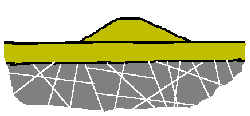From: Canadian Geotechnical
Journal, vol. IV, no. 3. Printed in Canada.
THE USELESSNESS OF ELEPHANTS IN COMPACTING FILL
RICHARD L. MEEHAN and NIKOM ISRANKURA
 Erosion
of irrigation canal embankments during the wet season is a perennial problem
in Northeast Thailand. Grass cover is often difficult to establish because,
among other reasons, the embankments are convenient pedestrian thoroughfares.
Proper compaction of the embankments is an obvious remedy which is seldom
applied for lack of suitable compaction equipment.
Erosion
of irrigation canal embankments during the wet season is a perennial problem
in Northeast Thailand. Grass cover is often difficult to establish because,
among other reasons, the embankments are convenient pedestrian thoroughfares.
Proper compaction of the embankments is an obvious remedy which is seldom
applied for lack of suitable compaction equipment.
Maintenance of embankments had become
a major problem along the main canal and laterals of the Lam Pra Plerg
Project, an irrigation development located 60 kilometers south of the town
of Korat. It occurred to the frustrated field engineers that local unemployed
elephants might be recruited at a reasonable rate to perform the compaction.
Although several opinions were offered on the efficacy of such a means,
no record of the performance of elephants as compactors was discovered.
Accordingly, it was decided to resolve this controversial question by undertaking
a modest field investigation.
Elephas maximus, the Asian elephant,
is regarded with particular affection by the Thai, who not only share our
delight at the wondrous sight of two tons of animal flesh, but also know
their elephants as dependable workers with an unparalleled capability for
dragging valuable timber from the thickest jungles. The enthusiasm amounts
to a national tradition; the distinguished Siamese monarch King Mongkut,
upon receiving word of the American Civil War, offered President Lincoln
a battle-trained squadron of elephants to crush the opposition. It was
no surprise, then, that as the day of the field test approached, all concerned
looked forward to the beasts proving themselves the equals of imported
machines.
PROCEDURE
A fill stockpile area at the headworks
was selected as a convenient site for the trial. The test material was
a sandy clay of low plasticity from a nearby excavation. Natural moisture
content was 4 to 5 per cent dry of optimum. The soil was spread by hand
in a 20 cm lift over an area 9 meters square, and divided by string into
9 square sections (see Figure 1), or 3 east-west lanes
of 3 meters width intersected by 3
similar north-south lanes. Different moisture contents were obtained in
each of north-south lanes by hand sprinkling, and different compactive
efforts were achieved in the east-west lanes by varying the number of coverages.
Two elephants, a cow and a bull, were used. In addition to the handler,
a qualified soils technician rode on each elephant during the time that
the animal was on the test lift. The intent was to direct the elephants
in file back and forth through the east-west Ianes a predetermined number
of times.
Unfortunately, the large number of
people that crowded onto the test section to watch the operation, the sharp
turns required, and the differing dialects of the handlers and technicians
confused and perplexed the elephants, so that it became necessary to remove
the more excitable cow from the area. In general, the test was completed
as planned, although it was necessary to increase the number of passes
well above original expectations. At the completion of the test, field
density determinations (sand cone method) were made in each of the square
formed by the intersecting lanes.
RESULTS
Field densities and moisture contents
are plotted alone with the Proctor density-moisture ontent curve in Figure
2. Numbers adjacent to the plotted points designate the number of elephant
passes. It is clear from the test results that this method of compaction
fails to produce adequate density. This is explained as follows:
1. The weight of the animal is supported
by three legs, even as it walks. The area of the imprint of each foot is
typically 175 sq. cm, so that its weight is distributed over an area of
about 525 sq. cm. Assuming a total weight of animal of 2000 kilograms,
the applied pressure is
3.8 kg/sq. cm (54 lb./sq. in.). While
this compares favourably with tire pressures of pneumatic rollers, the
rate of coverage is much slower, i.e., a far greater number of passes is
required for comparable coverage.
2. An elephant quickly learns to place
its feet on precompacted areas and to avoid the softer uncompacted areas.
The animal explores the terrain ahead with its trunk, a remarkable sensory
organ, and generally will place its feet on or near previous imprints.
Strenuous control by the handler is required to obtain uniform coverage.

It was concluded that elephants are
inefficient compactors, even considering the local low cost (current rate
of rental for one elephant and handler is $5per 6-hour day). Water buffalo,
also in abundant supply, are thought to be a more promising solution, although
no field trials have been made to evaluate this method to date.

 Erosion
of irrigation canal embankments during the wet season is a perennial problem
in Northeast Thailand. Grass cover is often difficult to establish because,
among other reasons, the embankments are convenient pedestrian thoroughfares.
Proper compaction of the embankments is an obvious remedy which is seldom
applied for lack of suitable compaction equipment.
Erosion
of irrigation canal embankments during the wet season is a perennial problem
in Northeast Thailand. Grass cover is often difficult to establish because,
among other reasons, the embankments are convenient pedestrian thoroughfares.
Proper compaction of the embankments is an obvious remedy which is seldom
applied for lack of suitable compaction equipment.




